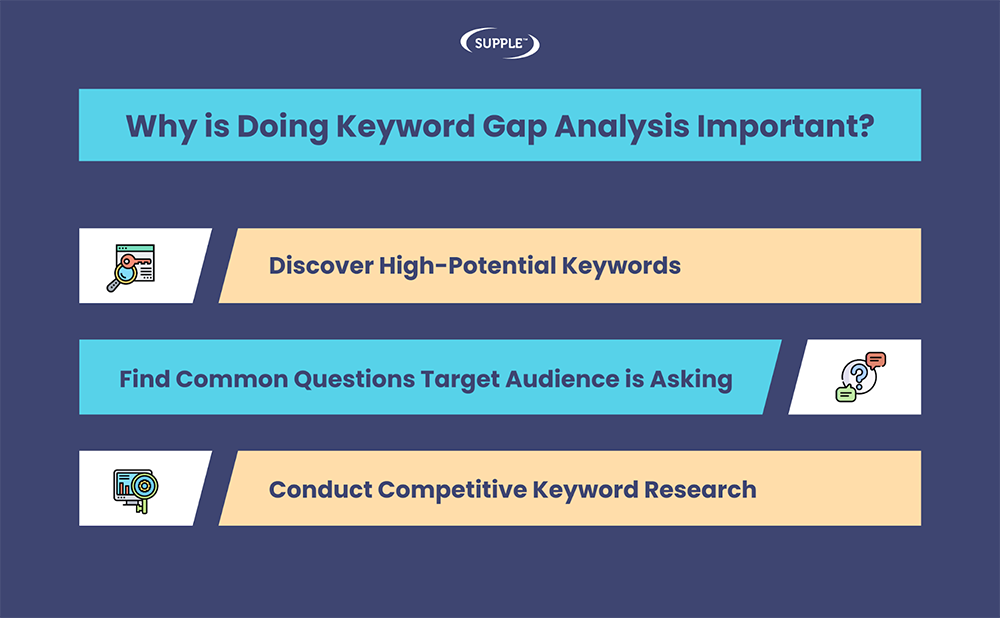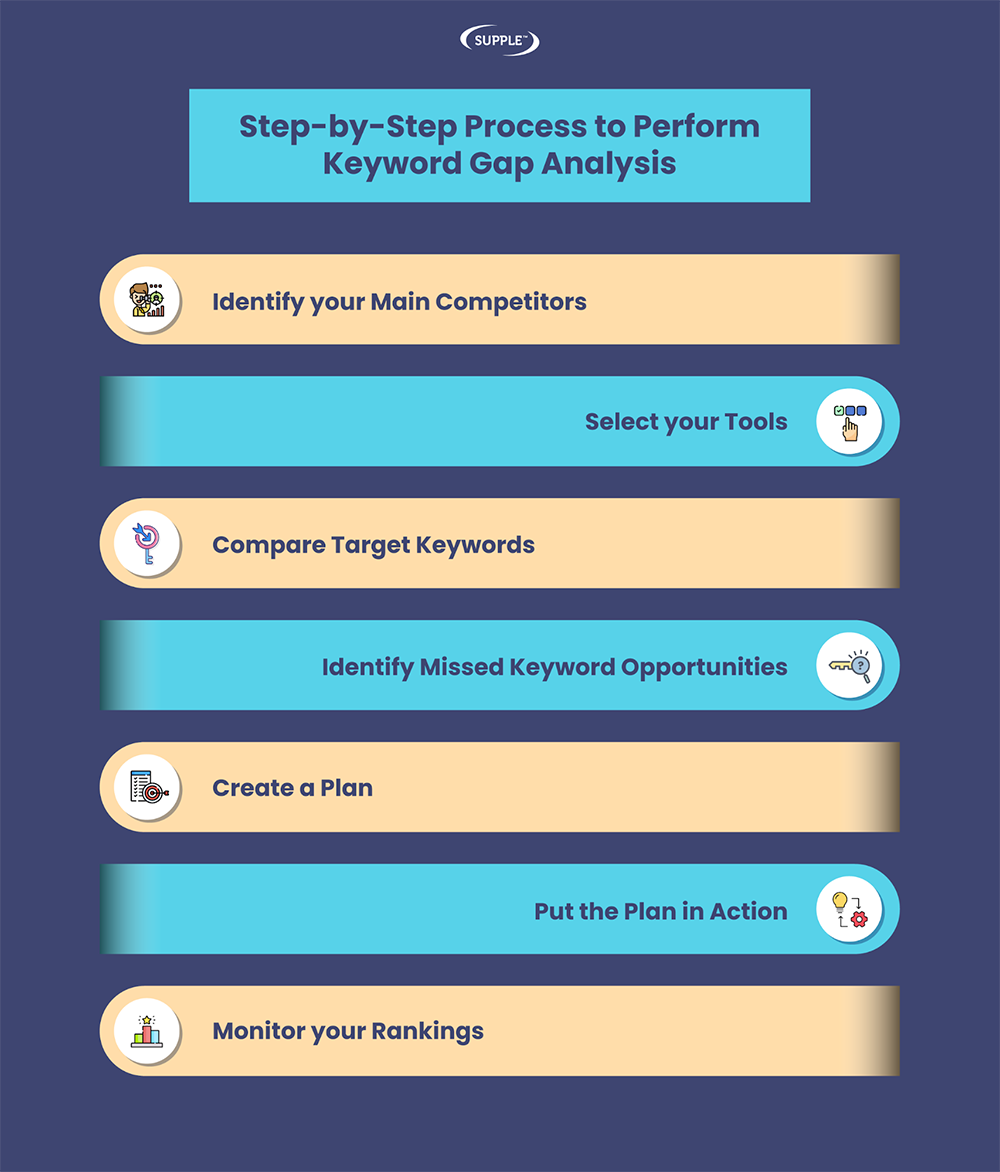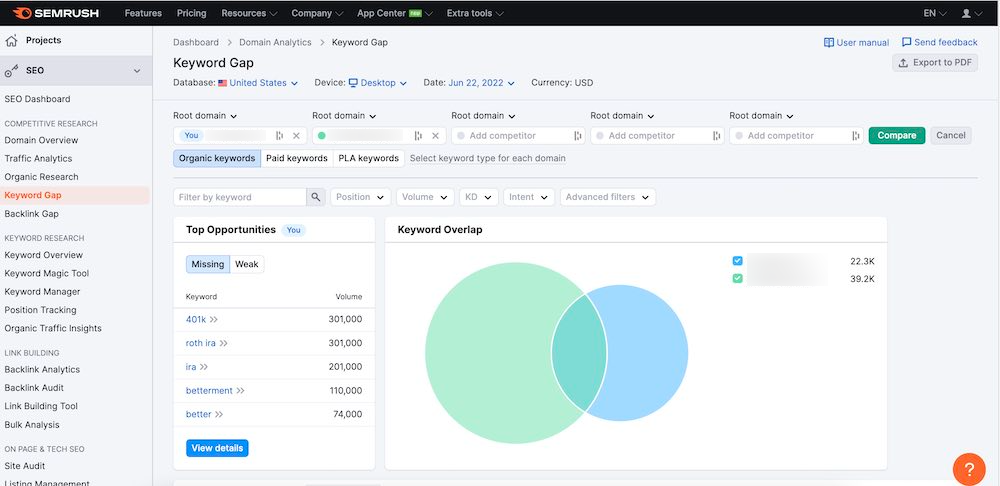Keyword Gap Analysis – A Guide to Identify and Close Your Keyword Gaps
In the world of SEO, identifying and targeting the right keywords can make all the difference in the success of your website or online business.
However, it’s not always easy to know which keywords to target, and there are often gaps in your keyword strategy that need to be filled.
This is where keyword gap analysis comes into the scene. By conducting a thorough analysis of your existing target keywords and comparing them to those of your competitors, you can identify gaps in your keyword strategy and take steps to close them.
In this article, we’ll explore the ins and outs of keyword gap analysis, why it is important, and how to conduct an analysis for filling keyword gaps to improve your SEO performance.
But first, let’s quickly understand the importance of keywords in SEO.
Why Do Keywords Matter?
Keywords, as you may already know, play a critical role in SEO because they are the words and phrases that searchers type in search engines like Google when they’re looking for information, products, or services online.
So, by finding and targeting keywords that your potential customers are using in search engines, you can increase your website’s visibility in Google SERPs and attract more target traffic to your website.
Plus, when you optimise your website for specific keywords, you can increase the likelihood of search engines recognising your website as relevant and authoritative for those keywords.
This, in turn, can lead to improved rankings in the search results pages, which can result in more searchers clicking through to your website.
What is Keyword Gap?
A keyword gap basically refers to the difference between the keywords that your website is currently ranking for and the keywords that your competitors are ranking for.
Having a gap in your keyword strategy simply means that you may be missing out on potential traffic and customers because you’re not targeting certain keywords that your competitors are targeting.
By identifying these keyword gaps, you can take steps to close them by adding those keywords to your own SEO strategy.
What is Keyword Gap Analysis?
As you can already guess, keyword gap analysis is a technique that involves identifying keywords that your competitors are ranking for, but you are not, and then taking steps to close those gaps by optimising your website’s content to target those keywords.
These keyword gaps are simply high-value keywords that you could potentially rank for by overtaking your competitors in Google search results.
To conduct a keyword gap analysis, you need to use a keyword gap tool to identify the keywords that your website and your competitors are currently ranking for. Then, you can compare the results to identify keywords that your competitors are ranking for that you are not.
Once you have identified such keyword gaps, you need to figure out ways to close these gaps to outrank competitors in the SERPs and drive more traffic to your website.
Why is Doing Keyword Gap Analysis Important?
There are various reasons for doing keyword gap analysis. Let’s take a look at the most important reasons why it’s worth doing keyword gap analysis.
Discover High-Potential Keywords
The primary reason to conduct a keyword gap analysis is to discover high-potential keywords that your competitors are ranking for, but you're not.
For example, if you run an eCommerce business in the fashion industry, performing keyword gap analysis can help to find out which keywords your competitors are ranking for that you’re not.
By analysing your competitors' keywords, you can discover new keyword opportunities for your own website and target those keywords.
This, in turn, can help you improve your search engine rankings, increase organic traffic to your website, and ultimately, boost your online visibility and sales.
Find Common Questions Target Audience is Asking
Another benefit of keyword gap analysis is that it can help you find common questions that your target audience is asking.
To elaborate, when you conduct keyword gap analysis, it allows you to analyse your competitors' content and find common questions that your target audience is asking.
And once you know the types of questions your target audience is asking, you can create a content strategy that addresses those question keywords.
As a result, not only can you fill the keyword gaps but also establish yourself as an authority in your industry and drive more organic traffic to your website.
Conduct Competitive Keyword Research
Keyword gap analysis mainly involves conducting competitive keyword research to find the keywords your competitors are ranking for.
This allows you to gain insights into their keyword and content strategy, which helps you make data-driven decisions about your own strategy.
This is because when you understand your competitors' keyword strategy, it becomes easier to find the areas where you can improve your own strategy and outrank the competition in Google search results.
In a nutshell, keyword gap analysis is a crucial part of any successful SEO strategy as it helps to discover keyword gaps, identify missed opportunities, and improve your SEO results.
How to Perform Keyword Gap Analysis to Find & Close Keyword Gaps
Now that you’ve understood the importance of keyword gap analysis, here are the steps you need to follow to find and close keywords gaps.
1. Identify your Main Competitors
The first step in performing keyword gap analysis is to identify your main competitors. These are the websites that are currently ranking for same target keywords as yours and are competing for the same target audience.
Ideally, you should find at least two or three competitors who have a strong organic traffic. If you’re not where to start or how to find your main competitors, you can start with a Google search.
Simply put, Google the keywords you’re most interested in ranking for and see who is currently ranking on the top positions in the first results page. This will give you an idea who your main competitors currently are.
Suppose you’re a local business offering plumbing services across Sydney. If you want to increase the number of inquiries from your website, you need to Google your primary target keywords (i.e. best plumber in Sydney) and see who are ranking at the top three positions.
Now, copy their URLs in a spreadsheet on your system, label them as your main competitors, and move onto step number two.
2. Select your Tools
Once you’ve identified your top competitors, the next step is to pick a keyword gap analysis tool.
There are plenty of tools out there (both free and paid) to choose from such as SEMrush, Ahrefs, Moz, and Spyfu to name a few.
These tools can help you find the keywords your competitors are targeting and ranking for, which you can analyse and find missed opportunities in your own keyword strategy.
3. Compare Target Keywords
Once you’ve finalised the tool you’re going to be using, you need to open up the tool and log in to your account.
After that, enter your website URL and your competitor’s URL and click on Compare. The keyword gap tool will give you a list of target keywords your competitor currently ranks for and where your website currently stands in the SERPs for the same target keywords.
For example, if you’re using SEMrush, you need to go to the left-side menu and click on the Keyword Gap option as shown in the screenshot below.
As you can see, SEMrush gives a lot of keyword gap insights such as keyword overlap, search volume, difficulty, competitive density, and even CPC among many other metrics.
To conduct an in-depth competitor analysis, you can simply download the report as a CSV file so that you can sort and search more easily.
4. Identify Missed Keyword Opportunities
After compiling the target keyword list of your competitors, you need to identify the missed keyword opportunities. These are the keywords that your competitors are ranking for, but you are not.
Now, if you want to look for missed opportunities yourself, you can consider extracting the complete keyword list of your competitors using the tool and look for keywords that are:
- Highly-relevant to your website or business
- Has a high potential traffic
- Not overly competitive
- Easy to create new content or update existing content for
Alternatively, you can also use the tools to analyse the keywords and find the ones that you should be targeting. In fact, if you’re using SEMrush, it will do some of the work for you.
For example, SEMrush has a section called “Top Opportunities” (see previous screenshot) that lists keywords that your website is either missing or has a lower ranking than your competitors.
5. Create a Plan
Once you have identified all missed keyword opportunities, you need to filter the list. Ideally, you should start by focusing on weak and missing keywords first.
For the uninitiated, weak keywords are basically keywords that your competitors are currently ranking higher than you in Google search results. Missing keywords, on the other hand, are keywords that your competitors are ranking for but you’re not ranking at all.
When creating a content plan, you either need to update the existing content or create new content to fill your keywords gaps.
Here's a simple rule that you can abide by:
- Weak Keywords — Update existing content
- Missing Keywords — Create new content
You can also consider prioritising which keyword opportunities to focus on first by either prioritising keywords that you’re already ranking for between position 10-20 or keywords that have low difficulty score.
6. Put the Plan in Action
Once you’ve decided whether to refresh an existing content or create new content, the next thing you need to do is analyse the top content that is already ranking on top positions for each keyword and make a note of following things:
- Type of content (blog post, case study, video, etc.)
- Content structure
- Content length and depth
- Keywords and headers used throughout the content
After doing this analysis, you need to ask yourself if you already have content that already fulfills these criteria. If you have, you can simply update it with new keywords. If you don’t, you need to create a new piece of content to target the new keywords.
7. Monitor your Rankings
Finally, you need to monitor your rankings for the new keywords that you have targeted. This will help you understand the impact of the new content that you have created and identify any further gaps in your keyword strategy.
You can use the same tools to track your rankings for the new keywords, and make adjustments to your content plan as needed.
In addition, monitoring the rankings of your new keywords can also help you identify any new keyword gaps that may have emerged as a result of changes in the search engine algorithms or in the behavior of your target audience.
As you may already know, search engines often update their algorithms (i.e. Google Helpful Content Update) to provide better and more relevant results to searchers. As a result, your rankings for newly targeted keywords may fluctuate.
But, by monitoring their rankings, you can identify these fluctuations and adjust your strategy accordingly so that you continue to rank well for your newly target keywords.
Find High-Potential Keywords with Keyword Gap Analysis
Performing a keyword gap analysis is a crucial step in optimising your WordPress website for securing top-rankings in search results. By following this process, not only can you find keywords gaps but also close them.
So, start implementing keyword gap analysis today and see the difference it can make to your online presence. If you're not still not sure how to get started, feel free to reach out to us for professional assistance.
FAQs
How do you run a keyword gap analysis?
To run a keyword gap analysis, use a keyword gap tool to identify missing opportunities, examine their search volume & difficulty, and create a content plan to target those keywords.
What is a keyword gap in digital marketing?
Keyword gap in digital marketing refers to the difference between the keywords that your website is currently ranking for, and the keywords that your competitors are ranking for but you're not.
What are the five basic steps in the gap analysis process?
The five basic steps in the gap analysis process are identifying top competitors, gather keyword data, find missed opportunities, develop a keyword strategy, and create content around those keywords.
What is gap analysis checklist?
A keyword gap analysis checklist helps website owners or businesses identify and analyse the gaps in their keyword strategy compared to their competitors.
What are the three fundamental components of a gap analysis?
The three fundamental keyword gap analysis components include analysing the performance of existing target keywords, identifying the missing keywords, and creating a content plan to fill those keyword gaps.
DIGITAL MARKETING FOR ALL OF AUSTRALIA
- SEO AgencyMelbourne
- SEO AgencySydney
- SEO AgencyBrisbane
- SEO AgencyAdelaide
- SEO AgencyPerth
- SEO AgencyCanberra
- SEO AgencyHobart
- SEO AgencyDarwin
- SEO AgencyGold Coast
- We work with all businesses across Australia





